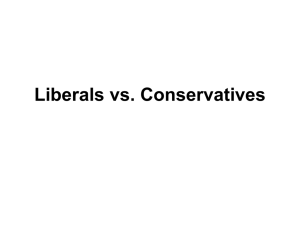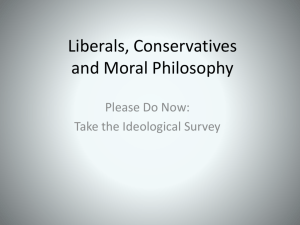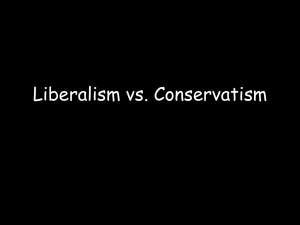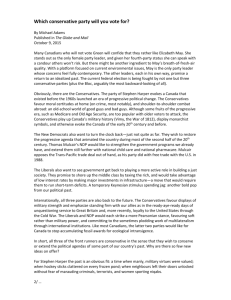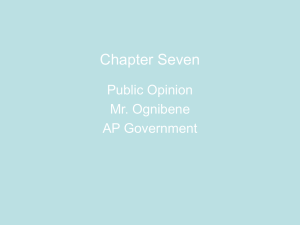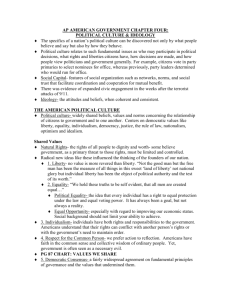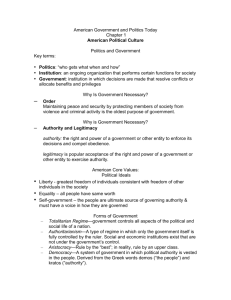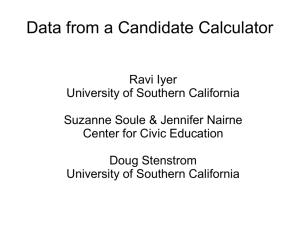The Political Spectrum The terms liberal, conservative, radical
advertisement
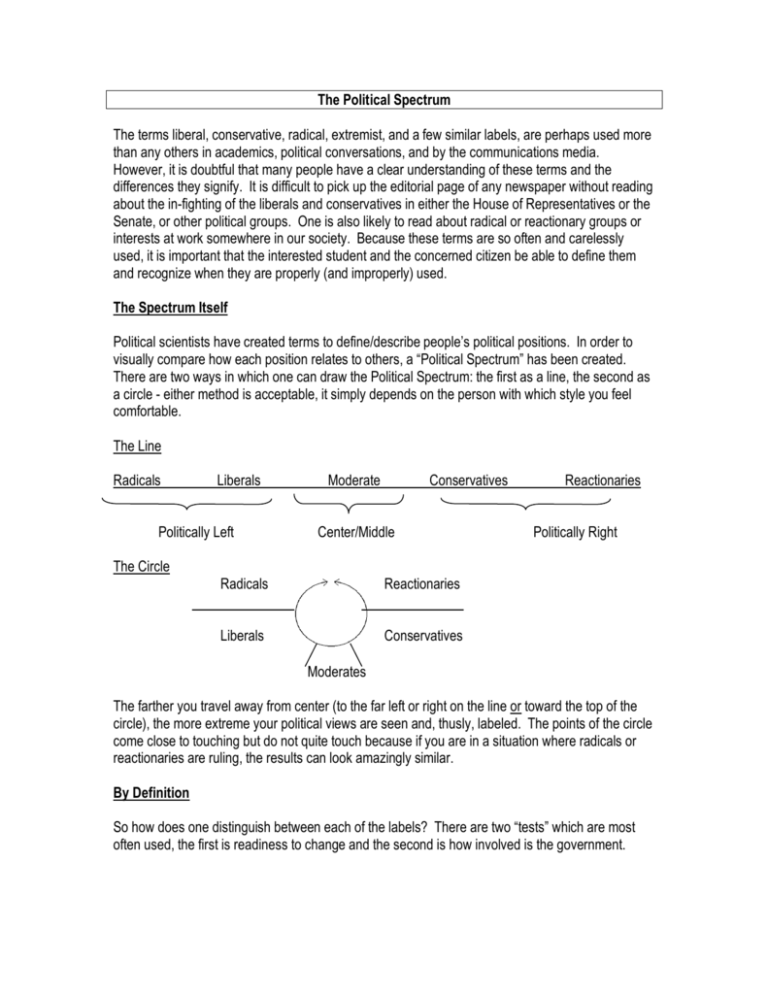
The Political Spectrum The terms liberal, conservative, radical, extremist, and a few similar labels, are perhaps used more than any others in academics, political conversations, and by the communications media. However, it is doubtful that many people have a clear understanding of these terms and the differences they signify. It is difficult to pick up the editorial page of any newspaper without reading about the in-fighting of the liberals and conservatives in either the House of Representatives or the Senate, or other political groups. One is also likely to read about radical or reactionary groups or interests at work somewhere in our society. Because these terms are so often and carelessly used, it is important that the interested student and the concerned citizen be able to define them and recognize when they are properly (and improperly) used. The Spectrum Itself Political scientists have created terms to define/describe people’s political positions. In order to visually compare how each position relates to others, a “Political Spectrum” has been created. There are two ways in which one can draw the Political Spectrum: the first as a line, the second as a circle - either method is acceptable, it simply depends on the person with which style you feel comfortable. The Line Radicals Liberals Politically Left Moderate Conservatives Center/Middle Reactionaries Politically Right The Circle Radicals Reactionaries Liberals Conservatives Moderates The farther you travel away from center (to the far left or right on the line or toward the top of the circle), the more extreme your political views are seen and, thusly, labeled. The points of the circle come close to touching but do not quite touch because if you are in a situation where radicals or reactionaries are ruling, the results can look amazingly similar. By Definition So how does one distinguish between each of the labels? There are two “tests” which are most often used, the first is readiness to change and the second is how involved is the government. Readiness to Change Liberals are often said to be “on the political left” while Radicals are often called “left-wingers” or “leftists,” as they are found further left on the political spectrum and they tend to welcome change. Conservatives are often said to be on the political right while reactionaries are often called rightwingers or rightists and are less/quite reluctant to accept change. If each position on the continuum were defined it might read as follows: The Radical: Favors a radical or basic change. Quite impatient and would quickly support a revolution to bring about the desired change. The Liberal: Is ready to move forward and accept change but would be considered a reformer rather than a revolutionary. The Conservative: Is quite content with things the way they are. The Reactionary: Wants change also, but wants to retreat into the past and restore the order of things the way they used to be. A former advisor of Franklin D. Roosevelt’s, Rexford Tugwell, skillfully uses the example of a community’s need for a new train station to illustrate the difference between liberals and radicals: “Liberals would like to rebuild the station while the trains are running; radicals prefer to blow up the station and forego service until the new structure is built.” One might add that conservatives would prefer to keep the old station, being satisfied with it, while reactionaries would abandon the station entirely since they do not approve of trains in the first place. Level of Government Involvement The best test for determining where an idea or action falls on the political spectrum is the level of government involvement. The more involved the government, the further left the concept – the less involved the government, the further right the concept. Liberals: Favor political and social reform, usually government-driven; favor increased federal services (welfare, social security, Medicare, student-loans, etc); government intervention in the economy; consumer protection ensured by the government; government involvement in protecting the environment; guaranteeing the rights of people; and one which is different than more involvement, Liberals tend to support less military. Conservatives: Tend to believe that a larger/powerful government threatens its citizen’s freedoms; support smaller government; support limited government involvement in economic issues (laissez-faire); tend to believe social problems should be handled on a smaller scale (statelevel, community-level, churches, etc), however, conservatives support a stronger military. Whatever the differences between the “left” and the “right” in accepting change and involving the government, all four viewpoints are helpful to society. They encourage us to discuss, debate, and compromise while all work toward the best in our society. Reading #2 – Some of the information is reiterated, hopefully supporting full understanding on your part. As you read this section, answer or complete the italicized sections as directed. Political Ideology: Liberal or Conservative? Disclaimer: Please remember that there are degrees in how liberal or conservative people are. Reminder: Your first test to determine if a statement, position, or person is liberal or conservative is to ask the test question, “How involved is the government?” Then, remember that (98% of the time) more involvement means liberal and less means conservative. Beyond that, please look over these additional “guides.” Liberals Tend to support political and social reform directed by or stemming from the government. Tend to support increased federal services and social programs to better society. What are some examples of federal (US Government) services you can think of? Brainstorm and list 3 examples of services here: Support government intervention in the economy. If the economy is depressed, the Government will strive to get involved. See if your group can think of the most classic example: Clue #1: 1930’s Clue #2: Franklin Delano Roosevelt What was the US experiencing at the time and what did FDR create in an attempt to solve the crisis? Support consumer protection. Classic example: the Ford Pinto. In the mid 1960’s, Ford sold the Pinto, a car which they knew would explode whenever it was in a rear-end collision over 25 mph. Ford decided it was more cost-effective to sell the car with the potential for settling lawsuits as opposed to recalling and repairing the faulty gas tank design. Ralph Nader (you might recognize his name?) wrote a book, Unsafe at Any Speed which exposed Ford and the Pinto debacle. In a more liberal approach to fixing the problem, the Federal Government decided it needed to create higher safety testing standards to protect the consumers. (Please understand, Conservatives would not want people to blow up in their cars either, they might, however, believe that if the public knows Ford is manufacturing cars which blow up, the public would respond by not purchasing Ford cars, thereby closing Ford’s doors without additional government involvement.) Would support the government setting environmental standards for companies, etc. Would support passing laws to protect people’s rights (e.g. Civil Rights Act, Americans with Disabilities Act) An exception to the “more government” test would be that liberals would tend to support a smaller military. Conservatives Fundamental belief of a classic conservative: A large/powerful government = a threat to citizen freedom. Traditionally believe in a smaller government. Believe there should be limited government involvement in economic issues (laissez faire/government hands off – and allow supply and demand and competition of a free market to drive the economy) Believe social problems are best served at local levels. Work through the following exercise to understand this statement (we can talk about it when I get back too, give it your best shot! On the issue of Hunger – L government approach: What are a couple of state and/or federal programs that address the issue of hunger? C government approach: Where are some places in the Twin Cities that address the issue of hunger? (Think of places our school works with through service projects, etc) How do the places you brainstormed above get their funding/supplies? Do you know how the government encourages the above funding/supplies? Conservatives tend to support issues that tie in to “morality” Conservatives break from the “less government” rule with the issue of military power – they tend to support a strong military.
